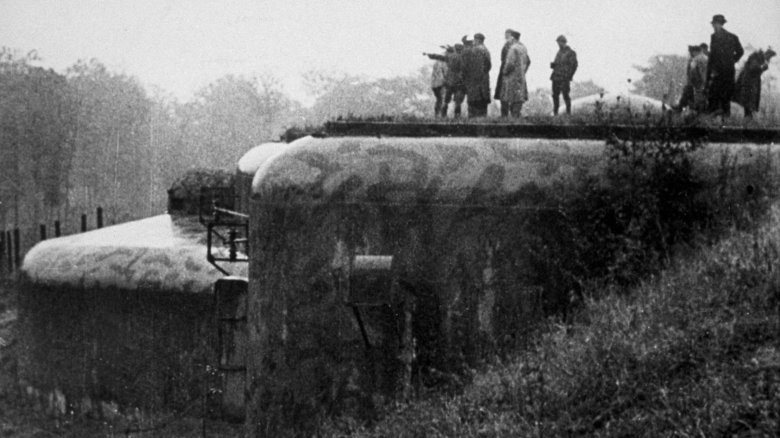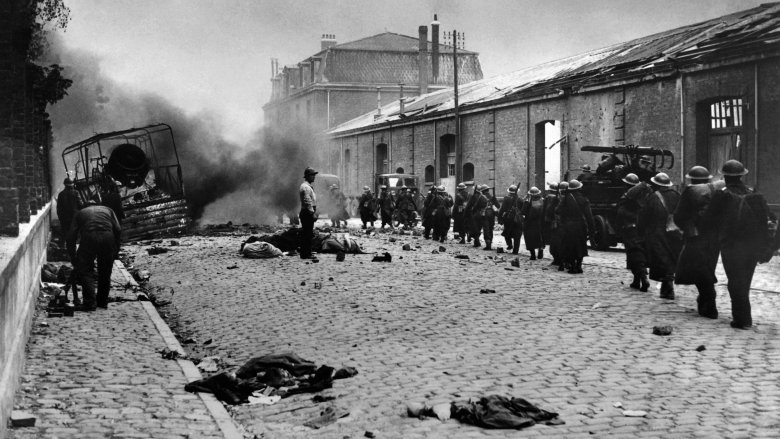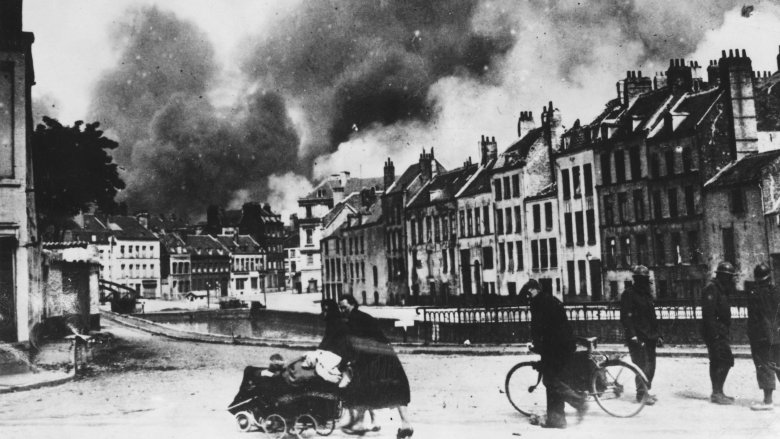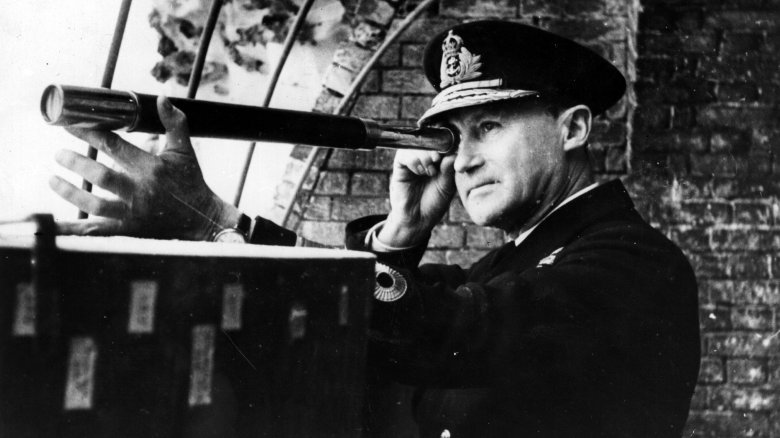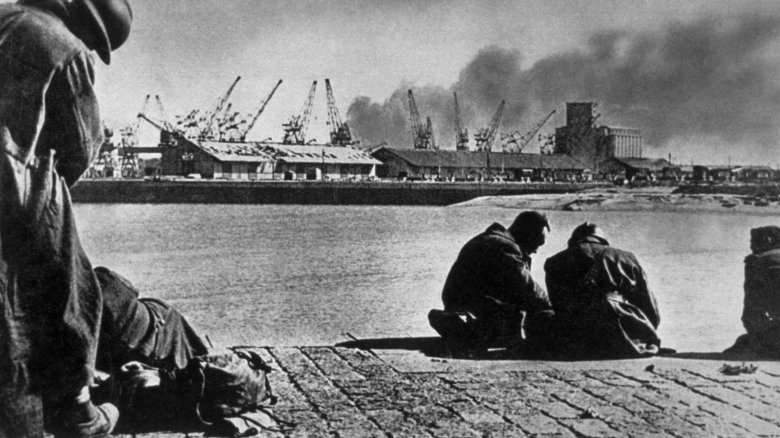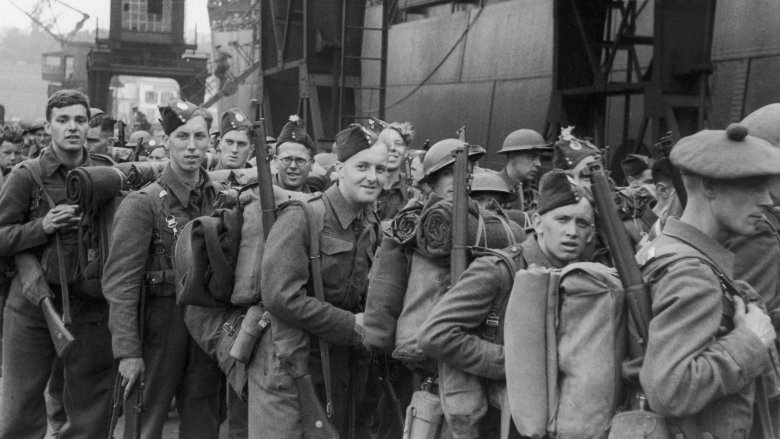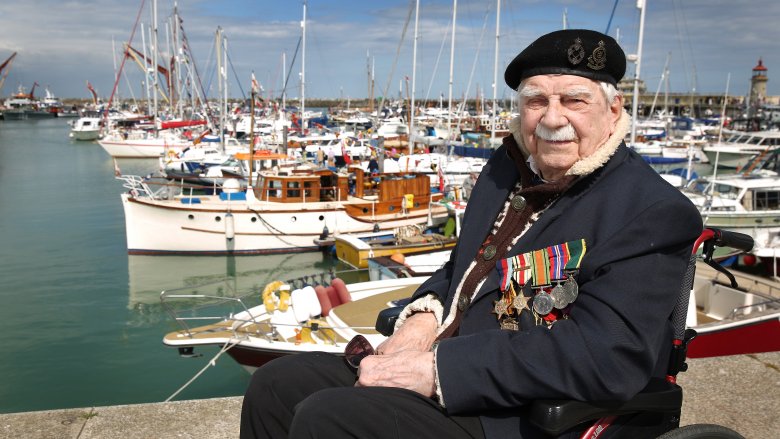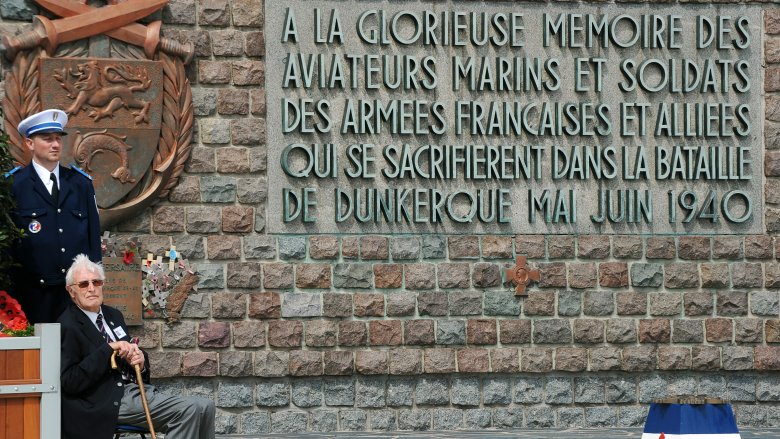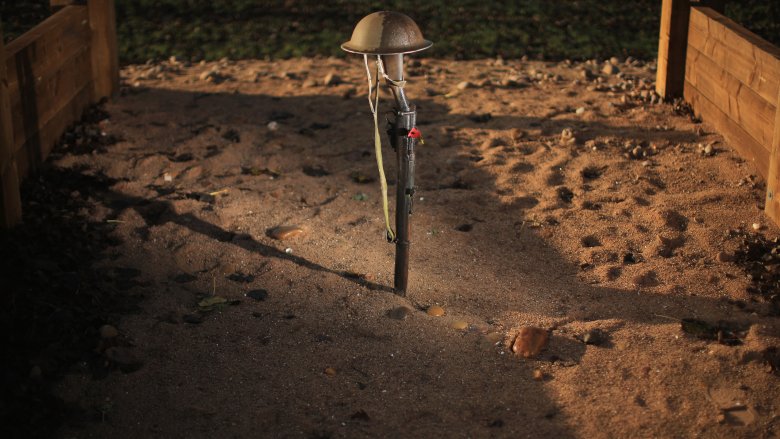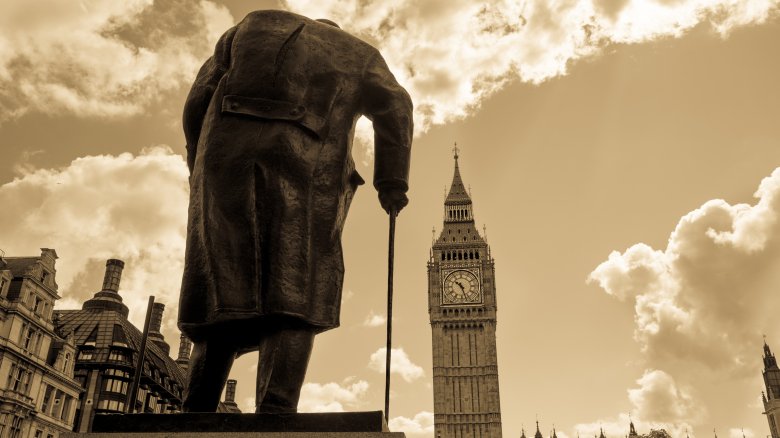The Untold Truth Of The Battle Of Dunkirk
Dramatized in Christopher Nolan's epic Dunkirk, the Battle of Dunkirk was much more than just a firefight between the Axis powers and Allied forces of World War II. It was May 1940, and the actions of leaders — and ordinary men — helped decide which way the war was going to go. It's often been studied and debated, but historians agree on the basics.
As the German army advanced through Holland, Luxembourg, and Belgium to march on France, things were looking dire for the British and French troops. The Allies retreated but were pinned against the French coast in the very definition of "a rock and a hard place." Around 15,000 soldiers dug in to hold off hostile forces as boatloads of men were shuttled to safety, allowing them to regroup and return in force later in the war. Those 15,000 souls saved more than 300,000 soldiers, and the entire story is incredible.
The Phoney War and the failure of the Maginot Line
In order to understand what pushed Allied forces into such dire circumstances in the first place, we need to go back to September 1939. According to The Telegraph, Poland fell to German forces, and Allied forces were pretty powerless to stop it. Britain and France watched and waited, and there was an uneasy sort of silence that lasted seven months. That period was called the Phoney War, and the world held its collective breath.
Dividing the German and Allied forces were two lines of fortifications: the German Siegfried Line and the French Maginot Line. The Maginot Line was a series of hundreds of buildings and 50 fortresses along France's western border, constructed with the goal of preventing a repeat of World War I invasions. The problem was that defenses tapered off through the Ardennes. The Ardennes Forest sits between France and Belgium, and since the two countries were friendly, France didn't think they needed to defend that border beyond the protection the impenetrable forest already offered. Rather, the Maginot Line was designed to have its strongest defenses between France and Germany, where the greatest threat was assumed to be. French strategists were fatally wrong. Belgium fell, and German troops stormed through the Ardennes. Around 1,500 tanks easily passed through the not-so-impenetrable-after-all forests as construction crews built roads with terrifying efficiency. The Maginot Line failed, and on May 24 — only 14 days after it had moved on the Netherlands — the German army was at Dunkirk.
The retreat to Dunkirk and the evacuation orders
Here's where history gets a little muddled. According to the BBC, there are a couple different interpretations of exactly what happened when the German army stormed its way into France. The French army was the largest at the time — five million men were called to service when the war started — and history hasn't been kind to them. A lot has been made of the French failure to stop the Germans as they marched across Europe, but the French did inflict heavy losses on the Germans even using outdated, older equipment against the German's state-of-the-art gear.
Historians looking at the events that led up to Dunkirk now say that the French army has been the target of a major injustice. The men fighting on the front lines didn't give up, they didn't just roll over, and they didn't just crumble in front of the German advance. They fought — and fought bravely — to let others retreat to Dunkirk and the French coast.
By the end of May, it was clear that the Allied forces were seriously outmanned and outgunned. According to The Telegraph, the British Expeditionary Force was under the command of General Lord Gort VC, and he was faced with making the decision of continuing to fight against overwhelming odds, or evacuating the French and British troops in hopes of regrouping and fighting another day. He gave the order to evacuate.
The mysterious German halt
On May 24, Hitler ordered his forces to halt just outside Dunkirk. Why? No one is 100 percent sure. The Allied army was bloody and beaten, and one of the greatest questions of the war is why Hitler didn't crush the remnants of the Allied army. Every war has its decisions that — in hindsight, at least — change the course of the war, and this was probably one.
Skeptoid took a crack at trying to figure out why Hitler halted the relentless march of his troops. The order was a ceasefire for 48 hours, presumably to rest, refuel, and regroup in preparation for the final push. By this time, they had been marching and fighting for a solid two weeks, and the army was exhausted. In the background, Hermann Goering was insisting that his planes could unleash hell onto whatever remained of the Allies and finish the war with minimal ground casualties. There's also another theory — well in the realm of conspiracy — that says Hitler stopped because he wanted to negotiate for peace.
Whatever the motivation, we do know that letters sent at the time talked about the defeat of the French and the British as though it had all been finished. It hadn't.
It was organized by one of the men who planned D-Day
As Allied troops dug into defensive positions on a French beach, British HQ was scrambling just across the Channel. They had a massive evacuation to pull off and not long to organize it. The man who did it was Vice Admiral Bertram Ramsay, and for a long time, his role in putting together the nuts and bolts of Operation Dynamo was overlooked.
Today, Dover Castle pays tribute to the Naval veteran and those under his command, all working from deep within the tunnels that weave their way through the Dover cliffs. Ramsay started planning the rescue on May 19, and ships were on their way on May 26.
Ramsay's role in World War II didn't end there. He was also a part of the inner circle that planned the D-Day invasion a few years later, as well as Operation Torch (the liberation of North Africa) and 1943's invasion of Sicily. So why don't we know his name? He had only returned to military service at the beginning of World War II. On January 2, 1945, he was leaving England for Brussels when his plane crashed on takeoff. Ten years after he had officially retired, Ramsay was dead. It wasn't until 2000 that a statue of him was installed in Dover Castle.
They faced some insurmountable odds
Hitler may have ordered a halt, but the Germans didn't intend to let the Allied troops evacuate easily. Shelling from above continued, and German bombers rained death down on the men crammed into Dunkirk. They could only wait, listening to the screams of dive-bombing German Stukas overhead — sounds that Popular Mechanics said the troops called "Jericho trumpets." Bombing was so fierce that Dunkirk's harbor was demolished on May 27, creating another problem. Now, the British big ships had nowhere to dock; the Royal Navy's biggest ships were ordered to pull out on May 29 but were ordered back on May 30. They had no choice.
There were other problems, too. The beach at Dunkirk faced water that was too shallow for the ships (large and small) of the British army. With the harbor out of commission, larger ships were forced to wait out in deep waters while smaller craft picked up soldiers and shuttled them out to sea and safety. Even those smaller boats had to wait hundreds of yards off the coast, and those hoping for rescue were faced with no choice but to leave the war-torn city and wade through the water. As the evacuation started, 15,000 men — French and British — set a perimeter around Dunkirk. They held back the advancing German troops on the ground while the Royal Air Force squared off with the German Stuka. By the end, the RAF chalked up 377 kills and only 87 losses.
They never expected to succeed like they did
Ramsay and the British command had to be realistic. They knew more than a quarter of a million soldiers were trapped at Dunkirk and hoping for rescue. Realistically, they expected to save 45,000 lives.
At first, that seemed hopelessly optimistic. The first day, only 7,669 men were pulled from the Dunkirk beaches. On the second day? 17,804. The slow start was due, in part, to the first ships being as much recon as rescue. When they first left England, they only knew they were going to somewhere near Dunkirk, along an area of beach 21 miles long. Later, ships honed in on a single location that would see 239,465 men to safety: The Mole, a stone jetty. By the time the evacuation was over, most estimates cite the final number of men rescued at around 338,000.
Hundreds of civilian vessels were brought into military service
Ramsay and his men issued an order for all privately owned craft to join military service, and this mini-fleet grew to include everything from fishing boats to yachts and steamers. They would become known as the Dunkirk Little Ships, and many of them still sail. In 2015, 50 of them made the trip from England to Dunkirk again for the 75th anniversary, carrying several soldiers who had been rescued by the little boats decades before, according to The Telegraph.
The littlest of the Little Ships was the Tamzine, a 15-foot fishing dinghy that's now on display at the Imperial War Museums. And another of the Little Ships — the Sundowner, which saved 130 people — was captained by a man named Charles Lightoller. Ring a bell? Lightoller served as the Second Officer on the Titanic, one of the officers in charge of filling the lifeboats.
Not all the ships made it back. In 2015, the BBC covered a touching tribute to the MV Crested Eagle, whose carcass can still be seen in the waters off Dunkirk. The memorial wreath was laid by 98-year-old veteran Vic Viner, who saluted the remains of the wreck that had claimed his brother's life. Both brothers had been at Dunkirk, with Vic coordinating soldiers amid the exhausted chaos of the beach. His brother had survived one bombed and sinking ship — the Grenade — only to be among the 300 who died in the fiery blaze that sank the Crested Eagle.
By the numbers, it was an Allied loss
What happened on the beaches of Dunkirk can be described in myriad ways, and in the days after the evacuation, the British spun it as a sad but glorious event. English Heritage says it was called "the miracle of Dunkirk" and that the image of righteous victory over aggression was helped by a strange weather pattern that kept the waters of the English Channel unusually calm, aiding the rescue. It gave rise to the idea of the "Dunkirk spirit," that strength of will that allows anyone to overcome anything.
But the numbers told a different story.
Of the 933 ships that participated in the evacuation, 236 didn't return home and another 61 were retired. The Germans captured about 40,000 French troops when Dunkirk fell; 68,111 men of the British Expeditionary Force were killed, and 1,000 Dunkirk citizens died alongside the soldiers, according to the BBC. History Extra reports that the total French losses were around 290,000, compared to only 27,074 German deaths. On June 5, Hitler announced, "Dunkirk has fallen. ... With it has ended the greatest battle in world history. Soldiers! My confidence in you knows no bounds. You have not disappointed me."
The consequences for those who stayed behind were catastrophic
The evacuation of so many soldiers came at a huge cost, and that price was paid by those who stayed behind to hold off the German forces. Their story wasn't even told at the time, but around 40,000 men were taken captive by the Germans, forced to march deep into German territory, and put to work in forced labor camps.
Other horrific stories have been told, too. A group of Royal Norfolk Regiment soldiers squared off against an SS Death's Head division in Paradis, France, keeping them busy while the evacuation took place. When they ran out of ammo, they surrendered, then were stripped of their valuables and executed. Two privates survived, escaping to England to tell their tale. The officer who gave the execution order was put on trial and hanged.
A similar scene played out in Wormhoudt. British soldiers were dispatched to stop advancing SS units, and those who were captured were massacred. There was one survivor: Private Albert Evans, who was 19 when he was ordered to stay and give others a chance to survive. Interviewed by The Telegraph in 2010, he said, "Thank God that we did our duty. Those men who died in that shed. They gave their lives so that the men could be taken off the beaches of Dunkirk. They did it because it was their duty."
Churchill acknowledged the entire thing as a 'disaster'
The successful evacuation of so many was, indeed, a miracle and a testament to the power of the human spirit. But at the same time the media was spinning Dunkirk as a miracle, Winston Churchill (who had only taken over as prime minister a couple weeks before) was cautious.
When he gave a speech on June 4, it was a rallying cry that made it clear the Allies were not done fighting. But he also acknowledged Dunkirk for what it was: "a colossal military disaster," as he told the House of Commons. Today, we remember the end of the speech: "We shall defend our island, whatever the cost may be, we shall fight on the beaches, we shall fight on the landing grounds, we shall fight in the fields and in the streets, we shall fight in the hills; we shall never surrender."
